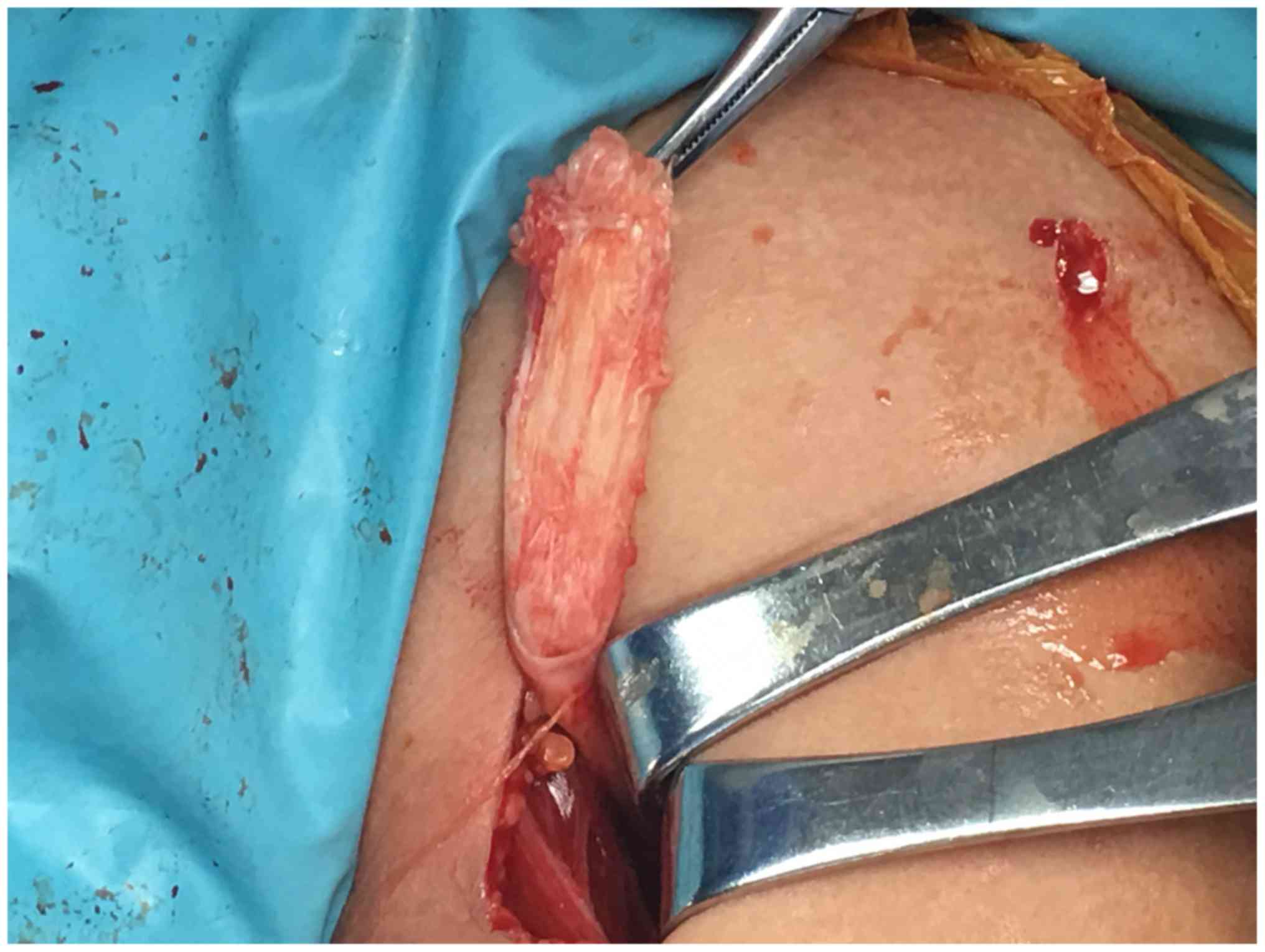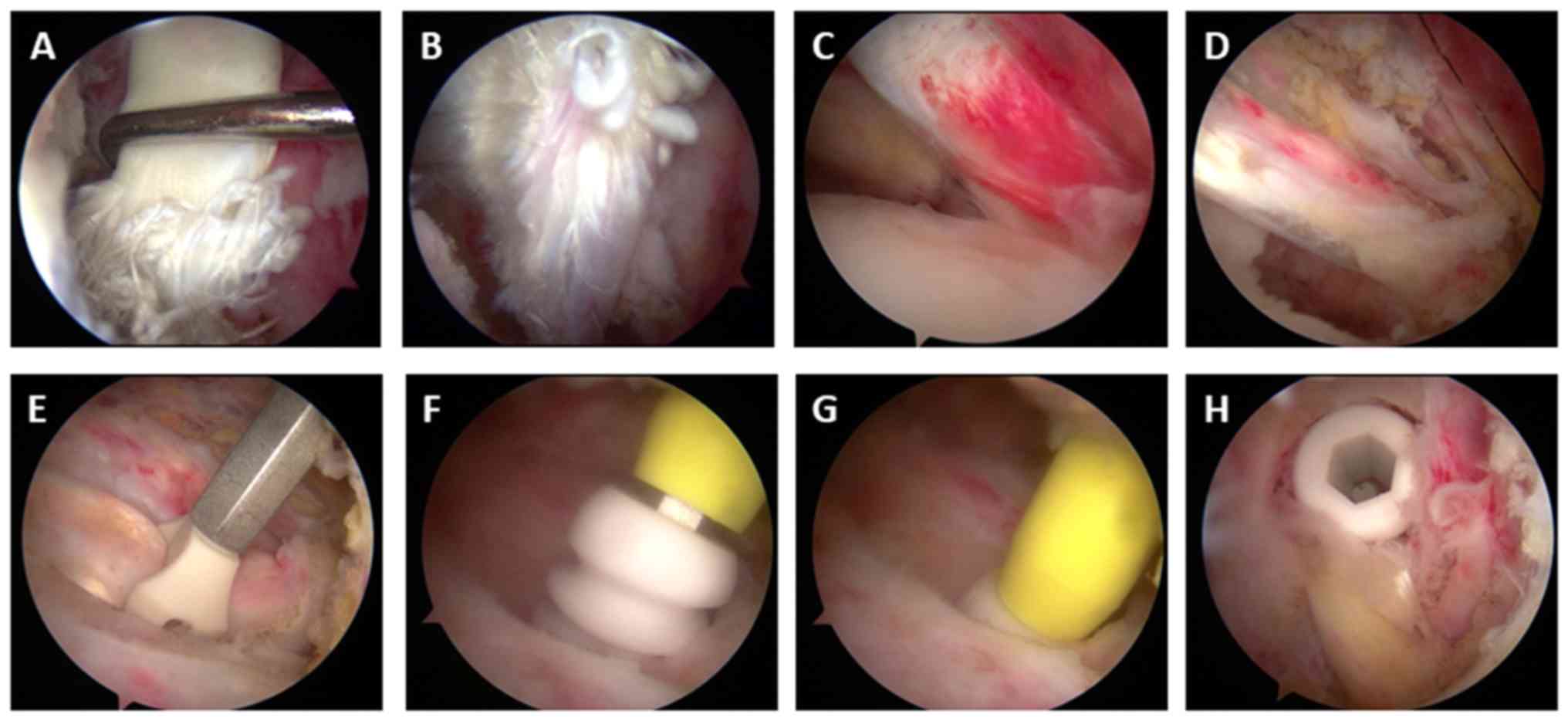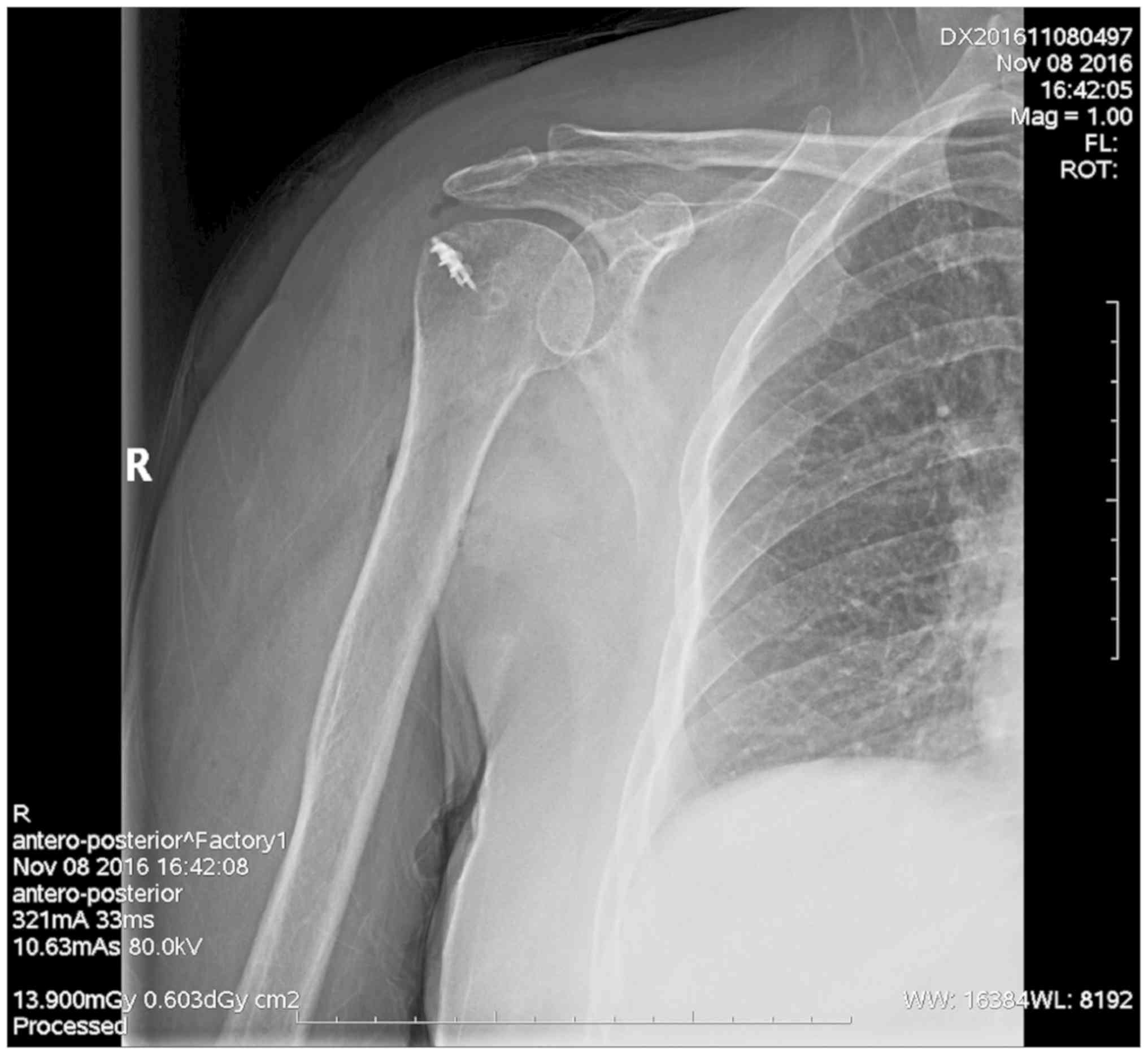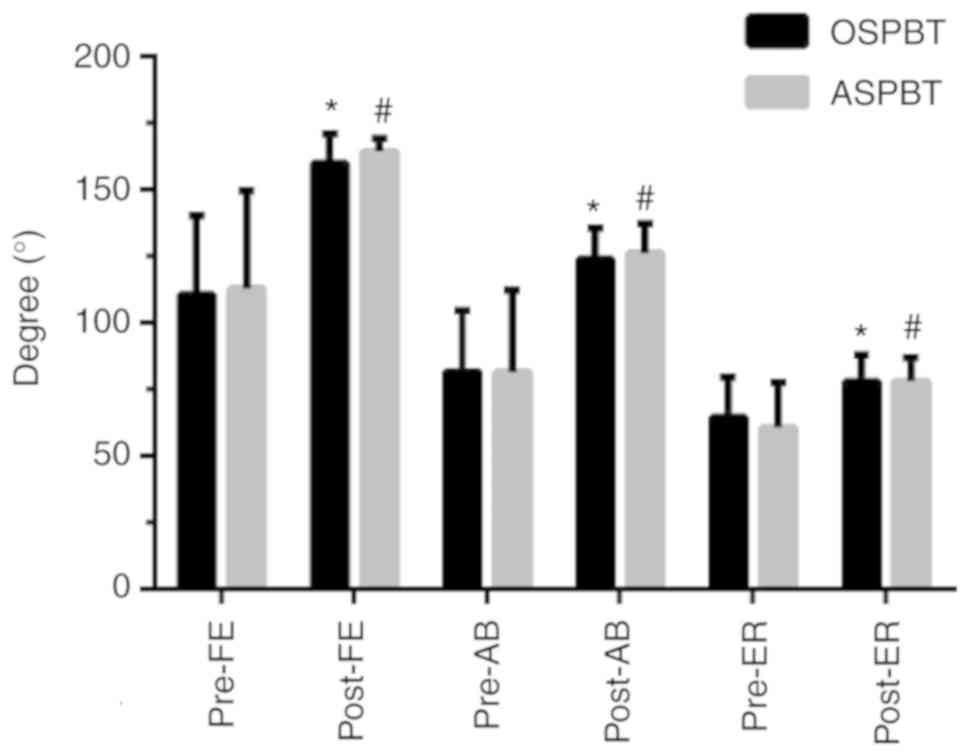|
1
|
Nair R, Kahlenberg CA, Patel RM, Knesek M
and Terry MA: All-arthroscopic suprapectoral biceps tenodesis.
Arthrosc Tech. 4:e855–e861. 2015. View Article : Google Scholar : PubMed/NCBI
|
|
2
|
Werner BC, Brockmeier SF and Gwathmey FW:
Trends in long head biceps tenodesis. Am J Sports Med. 43:570–578.
2015. View Article : Google Scholar : PubMed/NCBI
|
|
3
|
Levy DM, Meyer ZI, Campbell KA and Bach BR
Jr: Subpectoral biceps tenodesis. Am J Orthop (Belle Mead NJ).
45:68–74. 2016.PubMed/NCBI
|
|
4
|
AlQahtani SM and Bicknell RT: Outcomes
following long head of biceps tendon tenodesis. Curr Rev
Musculoskelet Med. 9:378–387. 2016. View Article : Google Scholar : PubMed/NCBI
|
|
5
|
Patel KV, Bravman J, Vidal A, Chrisman A
and McCarty E: Biceps tenotomy versus tenodesis. Clin Sports Med.
35:93–111. 2016. View Article : Google Scholar : PubMed/NCBI
|
|
6
|
Koh KH, Ahn JH, Kim SM and Yoo JC:
Treatment of biceps tendon lesions in the setting of rotator cuff
tears: Prospective cohort study of tenotomy versus tenodesis. Am J
Sports Med. 38:1584–1590. 2010. View Article : Google Scholar : PubMed/NCBI
|
|
7
|
Slenker NR, Lawson K, Ciccotti MG, Dodson
CC and Cohen SB: Biceps tenotomy versus tenodesis: Clinical
outcomes. Arthroscopy. 28:576–582. 2012. View Article : Google Scholar : PubMed/NCBI
|
|
8
|
Werner BC, Evans CL, Holzgrefe RE, Tuman
JM, Hart JM, Carson EW, Diduch DR, Miller MD and Brockmeier SF:
Arthroscopic suprapectoral and open subpectoral biceps tenodesis: A
comparison of minimum 2-year clinical outcomes. Am J Sports Med.
42:2583–2590. 2014. View Article : Google Scholar : PubMed/NCBI
|
|
9
|
Abraham VT, Tan BH and Kumar VP:
Systematic review of biceps tenodesis: Arthroscopic versus open.
Arthroscopy. 32:365–371. 2016. View Article : Google Scholar : PubMed/NCBI
|
|
10
|
Werner BC, Lyons ML, Evans CL, Griffin JW,
Hart JM, Miller MD and Brockmeier SF: Arthroscopic suprapectoral
and open subpectoral biceps tenodesis: A comparison of restoration
of length-tension and mechanical strength between techniques.
Arthroscopy. 31:620–627. 2015. View Article : Google Scholar : PubMed/NCBI
|
|
11
|
Chung SW, Huong CB, Kim SH and Oh JH:
Shoulder stiffness after rotator cuff repair: Risk factors and
influence on outcome. Arthroscopy. 29:290–300. 2013. View Article : Google Scholar : PubMed/NCBI
|
|
12
|
Johannsen AM, Macalena JA, Carson EW and
Tompkins M: Anatomic and radiographic comparison of arthroscopic
suprapectoral and open subpectoral biceps tenodesis sites. Am J
Sports Med. 41:2919–2924. 2013. View Article : Google Scholar : PubMed/NCBI
|
|
13
|
Grimes DA, Hubacher D, Nanda K, Schulz KF,
Moher D and Altman DG: The good clinical practice guideline: A
bronze standard for clinical research. Lancet. 366:172–174. 2005.
View Article : Google Scholar : PubMed/NCBI
|
|
14
|
Mazzocca AD, Rios CG, Romeo AA and Arciero
RA: Subpectoral biceps tenodesis with interference screw fixation.
Arthroscopy. 21:8962005. View Article : Google Scholar : PubMed/NCBI
|
|
15
|
David TS and Schildhorn JC: Arthroscopic
suprapectoral tenodesis of the long head biceps: Reproducing an
anatomic length-tension relationship. Arthrosc Tech. 1:e127–e132.
2012. View Article : Google Scholar : PubMed/NCBI
|
|
16
|
Lutton DM, Gruson KI, Harrison AK,
Gladstone JN and Flatow EL: Where to tenodese the biceps: Proximal
or distal? Clin Orthop Relat Res. 469:1050–1055. 2011. View Article : Google Scholar : PubMed/NCBI
|
|
17
|
Tahal DS, Katthagen JC, Vap AR, Horan MP
and Millett PJ: Subpectoral biceps tenodesis for tenosynovitis of
the long head of the biceps in active patients younger than 45
years old. Arthroscopy. 33:1124–1130. 2017. View Article : Google Scholar : PubMed/NCBI
|
|
18
|
Baggio M, Martinelli F, Netto MB, Martins
RO, da Cunha RC and Stipp WN: Evaluation of the results from
arthroscopic tenodesis of the long head of the biceps brachii on
the tendon of the subscapularis muscle. Rev Bras Ortop. 51:157–162.
2016. View Article : Google Scholar : PubMed/NCBI
|
|
19
|
Hwang JT, Yang CJ, Noh KC, Yoo YS, Hyun
YS, Lee YB and Liu X: Which is better for arthroscopic tenodesis of
the long head of the biceps: Soft tissue or bony interference
fixation? Arthroscopy. 32:560–567. 2016. View Article : Google Scholar : PubMed/NCBI
|
|
20
|
Chiang FL, Hong CK, Chang CH, Lin CL, Jou
IM and Su WR: Biomechanical comparison of all-suture anchor
fixation and interference screw technique for subpectoral biceps
tenodesis. Arthroscopy. 32:1247–1252. 2016. View Article : Google Scholar : PubMed/NCBI
|
|
21
|
Gombera MM, Kahlenberg CA, Nair R,
Saltzman MD and Terry MA: All-arthroscopic suprapectoral versus
open subpectoral tenodesis of the long head of the biceps brachii.
Am J Sports Med. 43:1077–1083. 2015. View Article : Google Scholar : PubMed/NCBI
|
|
22
|
Rhee PC, Spinner RJ, Bishop AT and Shin
AY: Iatrogenic brachial plexus injuries associated with open
subpectoral biceps tenodesis: A report of 4 cases. Am J Sports Med.
41:2048–2053. 2013. View Article : Google Scholar : PubMed/NCBI
|
|
23
|
McCormick F, Nwachukwu BU, Solomon D,
Dewing C, Golijanin P, Gross DJ and Provencher MT: The efficacy of
biceps tenodesis in the treatment of failed superior labral
anterior posterior repairs. Am J Sports Med. 42:820–825. 2014.
View Article : Google Scholar : PubMed/NCBI
|
|
24
|
Ma H, Van Heest A, Glisson C and Patel S:
Musculocutaneous nerve entrapment: An unusual complication after
biceps tenodesis. Am J Sports Med. 37:2467–2469. 2009. View Article : Google Scholar : PubMed/NCBI
|
|
25
|
Sethi PM, Vadasdi K, Greene RT, Vitale MA,
Duong M and Miller SR: Safety of open suprapectoral and subpectoral
biceps tenodesis: An anatomic assessment of risk for neurologic
injury. J Shoulder Elbow Surg. 24:138–142. 2015. View Article : Google Scholar : PubMed/NCBI
|
|
26
|
Gilmer BB, DeMers AM, Guerrero D, Reid JB
III, Lubowitz JH and Guttmann D: Arthroscopic versus open
comparison of long head of biceps tendon visualization and
pathology in patients requiring tenodesis. Arthroscopy. 31:29–34.
2015. View Article : Google Scholar : PubMed/NCBI
|
|
27
|
Euler SA, Horan MP, Ellman MB, Greenspoon
JA and Millett PJ: Chronic rupture of the long head of the biceps
tendon: Comparison of 2-year results following primary versus
revision open subpectoral biceps tenodesis. Arch Orthop Trauma
Surg. 136:657–663. 2016. View Article : Google Scholar : PubMed/NCBI
|
|
28
|
Kolz CW, Suter T and Henninger HB:
Regional mechanical properties of the long head of the biceps
tendon. Clin Biomech (Bristol, Avon). 30:940–945. 2015. View Article : Google Scholar : PubMed/NCBI
|
|
29
|
Yi Y, Lee JM, Kwon SH and Kim JW:
Arthroscopic proximal versus open subpectoral biceps tenodesis with
arthroscopy repair of small- or medium-sized rotator cuff tears.
Knee Surg Sports Traumatol Arthrosc. 24:3772–3778. 2016. View Article : Google Scholar : PubMed/NCBI
|


















